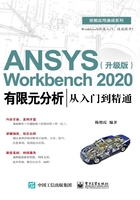
4.2 案例分析
上一节介绍了一般后处理的常用方法及步骤,下面通过一个简单的案例介绍后处理的操作方法。
4.2.1 问题描述
某铝合金模型如图4-28所示,请使用ANSYS Workbench 2020分析作用在侧面的压力为15 000N时,中间圆杆的变形及应力分布。

图4-28 铝合金模型
4.2.2 启动Workbench并建立分析项目
Step1:在Windows系统下选择“开始”→“所有程序”→“ANSYS 2020 R1”→“Workbench 2020 R1”命令,启动ANSYS Workbench 2020,进入主界面。
Step2:双击主界面Toolbox(工具箱)中的Analysis Systems→Static Structural(静态结构分析)命令,即可在Project Schematic(工程项目管理窗格)中创建分析项目A,如图4-29所示。

图4-29 创建分析项目A
4.2.3 导入几何体
Step1:右击A3栏的Geometry选项,在弹出的快捷菜单中选择Import Geometry→Browse命令,如图4-30所示,此时会弹出“打开”对话框。
Step2:在弹出的“打开”对话框中选择文件路径,导入Part.stp几何体文件,如图4-31所示,此时A3栏的Geometry选项后的![]() 图标变为
图标变为![]() 图标,表示实体模型已经存在。
图标,表示实体模型已经存在。

图4-30 选择Browse命令

图4-31 “打开”对话框
Step3:双击项目A中A2栏的Geometry选项,此时会进入DesignModeler平台界面,选择单位为mm,此时在模型树中的Import1前会显示![]() 图标,表示需要生成几何体,但图形窗口中没有图形显示,如图4-32所示。
图标,表示需要生成几何体,但图形窗口中没有图形显示,如图4-32所示。
Step4:单击![]() (生成)按钮,即可显示生成的几何体。
(生成)按钮,即可显示生成的几何体。
Step5:单击DesignModeler平台界面右上角的![]() (关闭)按钮,退出DesignModeler平台,返回Workbench 2020主界面。
(关闭)按钮,退出DesignModeler平台,返回Workbench 2020主界面。

图4-32 生成几何体前的DesignModeler平台界面
4.2.4 添加材料库
Step1:双击项目A中A2栏的Engineering Data选项,进入如图4-33所示的材料参数设置界面,在该界面下即可进行材料参数设置。
Step2:在界面的空白处右击,在弹出的快捷菜单中选择Engineering Data Sources(工程数据源)命令,此时的界面会变为如图4-34所示的界面。原界面中的Outline of Schematic A2:Engineering Data表消失,被Engineering Data Sources及Outline of General Materials表取代。

图4-33 材料参数设置界面1

图4-34 材料参数设置界面2
Step3:在Engineering Data Sources表中选择A4栏的General Materials选项,然后单击Outline of General Materials表中A4栏的Aluminum Alloy(铝合金)选项后的B4栏的![]() (添加)按钮,此时在C4栏中会显示
(添加)按钮,此时在C4栏中会显示![]() (使用中的)图标,如图4-35所示,表示材料添加成功。
(使用中的)图标,如图4-35所示,表示材料添加成功。

图4-35 添加材料
Step4:同Step2,在界面的空白处右击,在弹出的快捷菜单中选择Engineering Data Sources(工程数据源)命令,返回初始界面。
Step5:根据实际工程材料的特性,在Properties of Outline Row 4:Aluminum Alloy表中可以修改材料的特性,如图4-36所示。本实例采用的是默认值。
 用户也可以通过材料参数设置界面自行创建新材料并添加到模型库中,这在后面的讲解中会涉及,本实例不介绍。
用户也可以通过材料参数设置界面自行创建新材料并添加到模型库中,这在后面的讲解中会涉及,本实例不介绍。

图4-36 修改材料的特性
Step6:单击工具栏中的![]() 按钮,返回Workbench 2020主界面,完成材料库的添加。
按钮,返回Workbench 2020主界面,完成材料库的添加。
4.2.5 添加模型材料属性
Step1:双击项目A中A4栏的Model选项,进入如图4-37所示的Mechanical界面。在该界面下即可进行网格的划分、分析设置、结果观察等操作。
 ANSYS Workbench 2020程序默认的材料为Structural Steel。
ANSYS Workbench 2020程序默认的材料为Structural Steel。

图4-37 Mechanical界面
Step2:选择Mechanical界面左侧Outline(分析树)中的Geometry→Box1命令,即可在Details of“Box1”(参数列表)面板中给模型添加材料,如图4-38所示。
Step3:单击Material→Assignment栏后的![]() 按钮,会出现刚刚设置的材料Aluminum Alloy,选择该选项即可将其添加到模型中。如图4-39所示,表示材料已经添加成功。
按钮,会出现刚刚设置的材料Aluminum Alloy,选择该选项即可将其添加到模型中。如图4-39所示,表示材料已经添加成功。

图4-38 添加材料

图4-39 添加材料后的分析树
4.2.6 划分网格
Step1:选择Mechanical界面左侧Outline(分析树)中的Mesh命令,此时可在Details of“Mesh”(参数列表)面板中修改网格参数。本例在Defaults→Element Size栏中输入5.e-004m,其余选项采用默认设置,如图4-40所示。
Step2:右击Outline(分析树)中的Mesh命令,在弹出的快捷菜单中选择![]() Generate Mesh命令,最终的网格效果如图4-41所示。
Generate Mesh命令,最终的网格效果如图4-41所示。

图4-40 修改网格参数

图4-41 网格效果
4.2.7 施加载荷与约束
Step1:选择Mechanical界面左侧Outline(分析树)中的Static Structural(A5)命令,此时会出现如图4-42所示的Environment选项卡。
Step2:选择Environment选项卡中的Structural(结构)→Fixed(固定)命令,此时在分析树中会出现Fixed Support命令,如图4-43所示。

图4-42 Environment选项卡

图4-43 添加Fixed Support命令
Step3:选中Fixed Support命令,选择需要施加固定约束的面,单击Details of“Fixed Support”(参数列表)面板中Geometry栏的![]() 按钮,即可在选中的面上施加固定约束,如图4-44所示。
按钮,即可在选中的面上施加固定约束,如图4-44所示。
Step4:同Step2,选择Environment选项卡中的Structural(结构)→Force(力)命令,此时在分析树中会出现Force命令,如图4-45所示。

图4-44 施加固定约束

图4-45 添加Force命令
Step5:选中Force命令,在Details of“Force”(参数列表)面板中进行如下设置。
①在Geometry栏中确保如图4-46所示的面被选中并单击![]() 按钮,此时在Geometry栏中显示1Face,表明一个面已经被选中。
按钮,此时在Geometry栏中显示1Face,表明一个面已经被选中。
②在Define By栏中选择Components。
③在X Component栏中输入15000N,其他选项保持默认设置即可。

图4-46 施加面载荷
Step6:右击Outline(分析树)中的Static Structural(A5)命令,在弹出的快捷菜单中选择![]() Solve命令,进行求解,如图4-47所示。
Solve命令,进行求解,如图4-47所示。

图4-47 求解
4.2.8 结果后处理
Step1:选择Mechanical界面左侧Outline(分析树)中的Solution(A6)命令,此时会出现如图4-48所示的Solution选项卡。
Step2:选择Solution选项卡中的Results(结果)→Stress(应力)→Equivalent(von-Mises)命令,此时在分析树中会出现Equivalent Stress(等效应力)命令,如图4-49所示。

图4-48 Solution选项卡

图4-49 添加Equivalent Stress命令
Step3:同Step2,选择Solution选项卡中的Results(结果)→Strain(应变)→Equivalent(von-Mises)命令,此时在分析树中会出现Equivalent Elastic Strain(等效应变)命令,如图4-50所示。
Step4:同Step2,选择Solution选项卡中的Results(结果)→Deformation(变形)→Total命令,此时在分析树中会出现Total Deformation(总变形)命令,如图4-51所示。

图4-50 添加Equivalent Elastic Strain命令

图4-51 添加Total Deformation命令
Step5:右击Outline(分析树)中的Solution(A6)命令,在弹出的快捷菜单中选择![]() Solve命令,如图4-52所示。
Solve命令,如图4-52所示。
Step6:选择Outline(分析树)中的Solution(A6)→Equivalent Stress命令,此时会出现如图4-53所示的应力分析云图。

图4-52 选择Solve命令

图4-53 应力分析云图
Step7:选择Outline(分析树)中的Solution(A6)→Equivalent Elastic Strain命令,此时会出现如图4-54所示的应变分析云图。
Step8:选择Outline(分析树)中的Solution(A6)→Total Deformation(总变形)命令,此时会出现如图4-55所示的总变形分析云图。

图4-54 应变分析云图

图4-55 总变形分析云图
Step9:选择Solution选项卡中的![]() 命令,此时分别显示应力、应变及总变形分析云图,如图4-56~图4-58所示。
命令,此时分别显示应力、应变及总变形分析云图,如图4-56~图4-58所示。
Step10:选择Solution选项卡中的![]() 命令,此时分别显示应力、应变及总变形分析线图,如图4-59~图4-61所示。
命令,此时分别显示应力、应变及总变形分析线图,如图4-59~图4-61所示。

图4-56 应力分析云图

图4-57 应变分析云图

图4-58 总变形分析云图

图4-59 应力分析线图

图4-60 应变分析线图

图4-61 总变形分析线图
Step11:选择Solution(A6)命令,选择Solution选项卡中的![]() 命令,此时绘图窗格中会弹出如图4-62所示的后处理列表。
命令,此时绘图窗格中会弹出如图4-62所示的后处理列表。
Step12:选中Available Solution Quantities单选按钮,此时绘图窗格中会显示如图4-63所示的后处理列表。

图4-62 后处理列表1

图4-63 后处理列表2
Step13:右击ENERGY选项,在弹出的快捷菜单中选择Create User Defined Result命令,如图4-64所示。
Step14:此时在Outline中会出现ENERGYPOTENTIAL命令,右击该命令,在弹出的快捷菜单中选择![]() Equivalent All Results命令,此时绘图窗格中会显示如图4-65所示的云图。
Equivalent All Results命令,此时绘图窗格中会显示如图4-65所示的云图。
Step15:选择Solution(A6)命令,选择Solution选项卡中的User Defined Result![]() 命令,此时会出现如图4-66所示的Details of“User Defined Result”面板。在该面板的Expression栏中输入关系式=2*sqrt(UX^3)并进行计算,此时会显示如图4-67所示的自定义云图。
命令,此时会出现如图4-66所示的Details of“User Defined Result”面板。在该面板的Expression栏中输入关系式=2*sqrt(UX^3)并进行计算,此时会显示如图4-67所示的自定义云图。

图4-64 选择Create User Defined Result命令

图4-65 云图

图4-66 Details of“User Defined Result”面板

图4-67 自定义云图
4.2.9 保存与退出
Step1:单击Mechanical界面右上角的![]() (关闭)按钮,退出Mechanical界面,返回Workbench 2020主界面。
(关闭)按钮,退出Mechanical界面,返回Workbench 2020主界面。
Step2:在Workbench 2020主界面中单击工具栏中的![]() (保存)按钮,在“文件名”文本框中输入Part.wbpj,保存包含分析结果的文件。
(保存)按钮,在“文件名”文本框中输入Part.wbpj,保存包含分析结果的文件。
Step3:单击界面右上角的![]() (关闭)按钮,退出Workbench 2020主界面,完成项目分析。
(关闭)按钮,退出Workbench 2020主界面,完成项目分析。